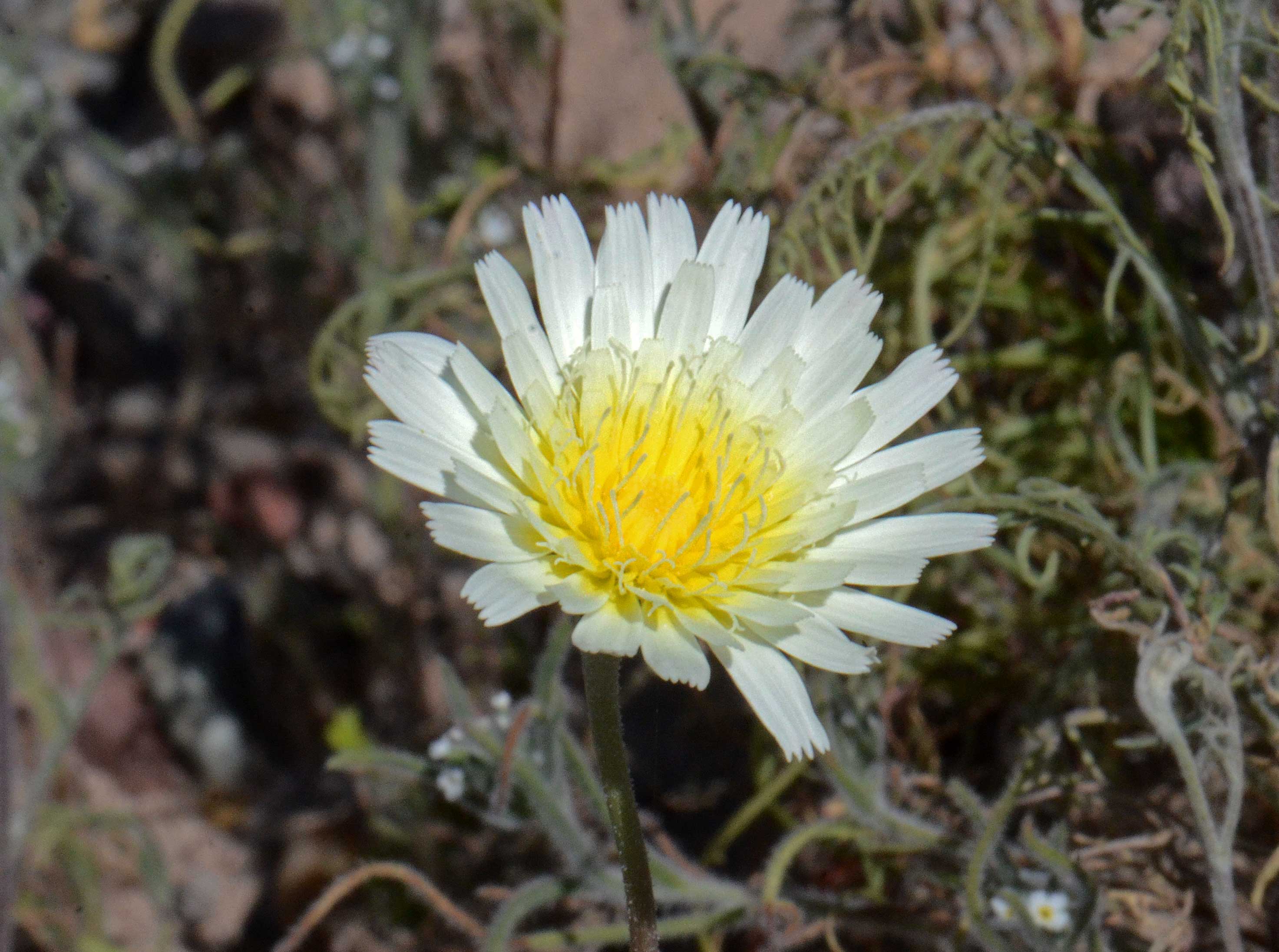|
|
|
|
Family: Asteraceae
smooth desertdandelion
[Malacothrix californica var. glabrata D.C. Eat. ex Gray] |
Annuals, (5-)10-40+ cm. Stems (1-)3-5+, ascending to erect, usually branched proximally and distally, glabrous or sparsely arachno-puberulent near bases (sometimes glaucous). Cauline leaves: proximal usually pinnately lobed (lobes 3-6+ pairs, usually filiform, subequal to unequal, apices acute), ultimate margins entire, faces glabrous or ± hairy (then usually glabrescent); distal reduced (usually pinnately lobed). Calyculi of 12-20+, lanceolate to linear bractlets, hyaline margins 0.05-0.2 mm wide (abaxial faces often ± densely white-hairy). Involucres campanulate to hemispheric, 9-17 × 4-7 mm. Phyllaries 20-25+ in 2-3 series, lance-linear to linear, hyaline margins 0.05-0.3 mm wide, faces usually glabrous, abaxial sometimes ± white-hairy. Receptacles bristly. Florets 31-139; corollas usually pale yellow, sometimes white, 15-23+ mm; outer ligules exserted 9-15+ mm. Cypselae ± cylindro-fusiform (sometimes weakly 5-angled), 2-3.3 mm, ribs extending to apices, usually ± equal; persistent pappi of 0-12+, blunt to acute teeth plus 1-2(-5) bristles. Pollen 70-100% 3-porate. 2n = 14. Flowering Mar-Jul. Coarse soils in open areas, or among shrubs, creosote bush scrublands, Amsinckia, Artemisia, and Atriplex-Larrea associations, Joshua tree woodlands; 0-1800 m; Ariz., Calif., Idaho, Nev., N.Mex., Oreg., Utah; Mexico (Baja California, Sonora). Malacothrix glabrata grows in the Mojave, Great Basin, and Sonoran deserts in California and the Intermountain region in Arizona, Nevada, Oregon, and Utah.
FNA 2006, Wiggins 1964, Kearney and Peebles 1969 Duration: Annual Nativity: Native Lifeform: Forb/Herb General: Ascending, moderately branched, wholly glabrous plant except slightly pubescent on youngest leaves in some plants, and on smallest outer involucral bracts, stems 10-40 cm tall. Leaves: Leaves 1-2 x pinnatifid, cauline near base, usually with 2-3 or rarely only 1 large head at tips of upper branches; basal leaves oblong-oblanceolate, 2-8 cm long, sinuately lobed to remotely pinnatifid into linear segments, glabrous. Flowers: Involucres 5-12 mm high, glabrous or lowest bracts sparsely arachnoid-pubescent; ligules yellow, often tinged with purple or lavender on lower surface. Fruits: Cypselae cylindric, 1.6-2 mm long, finely and evenly 15-ribbed or nerved, glabrous, truncate and with a low ring of tissue at apex, bearing a white-scarious, denticulate ring inside that tissue; pappus bristles white, 5-6 mm long. Ecology: Found on sandy and gravelly plains, rocky hillsides and mesas below 7,000 ft (2134 m); flowers March-June. Distribution: s OR, s ID, CA, NV, UT, AZ, s NM; south into Baja MEX. Notes: Distinguished by the annual life form, mostly basal, divided leaves with linear, filiform, terete lobes; white-yellow ligulate flowers tinged with purple on undersides; and phyllarees ranging from glabrate to densely hairy. Ethnobotany: The roots were used by the Apache as a blood medicine. Etymology: Malacothrix is from malakos, soft and thrix, hair, while glabrata means somewhat glabrous. Synonyms: Malacothrix californica var. glabrata Editor: SBuckley, 2010 |


